Peace Lily (Spathiphyllum): Varieties, Benefits, and How to Care Guide
Are you fond of flowers or is your home simply too dull and you want to spruce it up? Getting an indoor Peace Lily might be the ideal solution. Besides, the plant is very easy to care for and will serve you for a long time. If you are longing for a peaceful and calm environment, growing a Peace Lily indoors will easily do the trick. The plant is also an air purifier and your constant allergies might as well disappear when you grow it indoors. Learn more about the Peace Lily below.
What is Peace Lily?
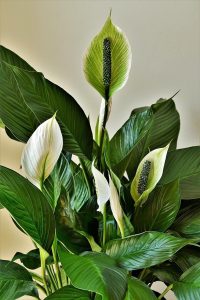
A Peace Lily is one of the most popular houseplants grown for its attractive blooms and foliage. This plant is native to Southeast Asia and America. There are different types of Peace Lily plants that you can consider growing from variegated Peace Lilies to solid-color Peace Lilies.
Most Lily plants have large, shiny leaves and occasionally produce attractive flowers in shades of white or cream. Peace Lilies mostly bloom during spring but the blooming period might vary when grown indoors.
This plant will add a touch of vibrancy to your home with its brightly colored spathes. Pink Peace Lilies or red Peace Lilies are not Peace Lilies but Anthuriums which also produce brightly colored spathes.
The Peace Lily would be an ideal choice if you are looking for an easy plant. However, you still have to provide ideal conditions for your plant to thrive. The Peace Lily can grow up to 4 feet tall when grown indoors and up to 6 feet outdoors.
Benefits of Peace Lilies
Below are some benefits you will get from growing a Peace Lily.
Purifies the air
The Peace Lily is among the best indoor plants for bedrooms since it purifies the air. The plant gets rid of toxins like carbon monoxide and produces ample oxygen at night.
Spruces up your home
The Peace Lily is an ornamental plant that adds color to your home. A Peace Lily will brighten up that dull corner in your home and while at it, create a serene environment that you look forward to after a hard day’s work.
Peace Lily Varieties
There are different types of Peace Lily plants you can choose from. All you have to do is search for Peace Lily near me online. Some kinds of Peace Lily plants are small while others are large. Below are different Peace Lily varieties with pictures.
Sensation Peace Lily (Spathiphyllum Sensation)
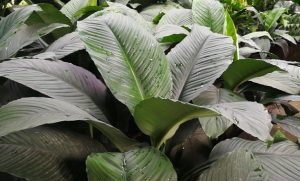
The Sensation Peace Lily is one of the giant Peace Lily varieties that can grow up to 6 feet tall. This plant has large broad deep green leaves that add a tropical vibe to your home. The plant’s leaves are ribbed to absorb adequate light. The Sensation Peace Lily produces beautiful white blooms that breathe life into your space.
Walisii Peace Lily (Spathiphyllum Walisii)
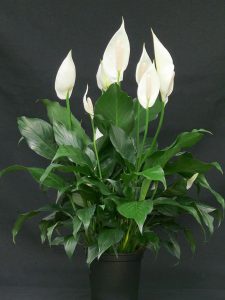
The Walisii Peace Lily is a small Peace Lily variety that grows up to 15 inches. The plant has green rippled leaves that droop. The Walisii Peace Lily produces eye-catching white blooms that brighten up any space. This plant is compact and would be ideal if you have limited space in your home.
Domino Peace Lily (Spathiphyllum Domino)
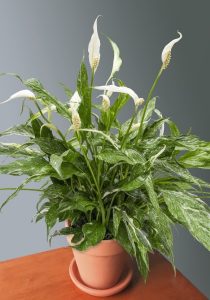
The Domino Peace Lily plant is one of the Variegated Peace Lily varieties that will enhance the aesthetic appeal of your home with its attractive foliage and flowers. This plant has ruffled green leaves with white streaks. Its variegated foliage blends well with its beautiful white blooms.
Peace Lily Picasso (Spathiphyllum Picasso)
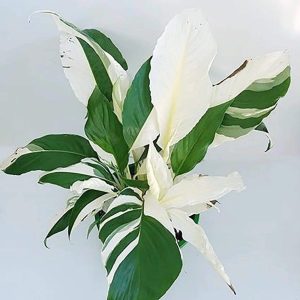
The Peace Lily Picasso is one of the most ornate Peace Lily varieties with very attractive foliage. It is almost as if Picasso himself created the artistic leaves. The plant’s leaves are variegated with green and white hues.
Allison Peace Lily (Spathiphyllum Allison)
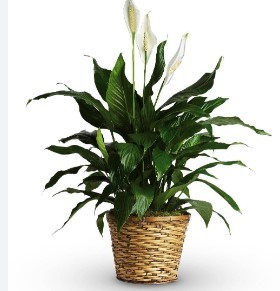
The Allison Peace Lily is a medium-sized Peace Lily variety that can grow up to 2 feet. This plant has green medium-sized leaves and produces attractive white blooms that resemble Calla Lilies. This plant is low maintenance and would be ideal for beginners.
Clevelandii Peace Lily (Spathiphyllum clevelandii)
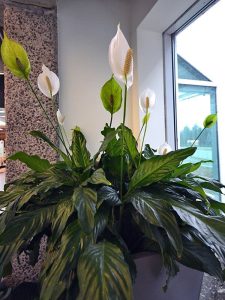
The Clevelandii Peace Lily is a unique medium-sized Peace Lily variety that would make a great indoor plant addition. The plant has long green leaves that can grow up to 18 inches long and produces large white blooms. This plant will add a bold dramatic effect to your home.
Power Petite Peace Lily (Spathiphyllum Power Petite)
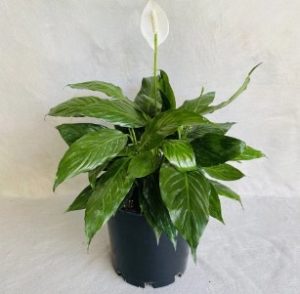
The Power Petite Peace Lily variety gets its name from its compact size. This plant is a small Peace Lily variety that would look stunning in your home. The Power Petite plant has small glossy green flowers and white flowers.
Bongo Bongo peace Lily (Spathiphyllum Bongo Bongo)

The Bongo Bongo Peace Lily has attractive foliage that contrasts well with its flowers. The plant features large dark-green glossy leaves that are deeply veined. The plant produces beautiful white blooms that would look great in any interior décor.
Annette Peace Lily (Spathiphyllum Annette)
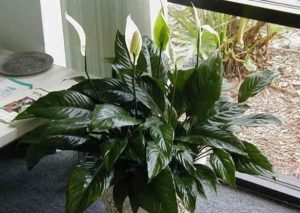
The Annette Peace Lily resembles other Peace Lily varieties. What makes the plant different is its slightly curved white blooms. This plant has medium-sized deep green glossy leaves that are rippled. The Annette Peace Lily would make an excellent indoor plant in your home.
Jetty Peace Lily (Spathiphyllum Jetty)
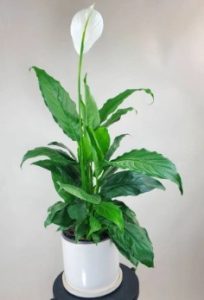
The Jetty Peace Lily is a striking Peace Lily variety with lush foliage. This plant has green, shiny leaves and produces attractive white flowers. The Jetty Peace Lily can grow up to 2 feet high. You can grow your Peace Lily indoors under ideal conditions.
How to care for Peace Lilies
Caring for Peace Lilies is not tasking. All you have to do is provide suitable conditions for your plant to thrive. Below is how you care for your Peace Lily.
Peace Lily soil type
A healthy Peace Lily needs well-draining soil that is rich in organic matter. Plant your Peace Lily in a loose soil mixture that drains water properly. Growing your plant in soil that retains moisture will cause root rot and your plant will die.
Peace Lily water
For your plant to thrive, it needs moderate watering. You can water your Peace Lily when the top inch of the soil becomes dry. Keep the soil slightly moist but not soggy. The plant can tolerate mild drought but its leaves will begin to turn brown when you leave the soil dry for too long. The plant itself will indicate when it needs water through its drooping leaves.
The Peace Lily is sensitive to chemicals present in water like chlorine. If you can access distilled water, use that to water your plant. Be careful not to overwater your plant to prevent root rot. Always ensure that the water completely drains out after watering your plant.
Peace Lily sunlight
Most Peace Lily varieties prefer bright to medium indirect sunlight to thrive. Peace Lilies that get adequate lighting tend to bloom regularly. Low-light Peace Lilies don’t bloom often.
You should be careful not to overexpose your Peace Lily to bright sunlight as the intense light will scorch your plant. Low light levels will also make your plant appear stretchy. The best position to place your plant would be near an east-facing window.
Peace Lily humidity and temperature
Peace Lilies are tropical plants that require warm and humid conditions to remain healthy. The suitable temperature range for your Peace Lily would be between 60 and 80 degrees. Temperatures below 55 degrees will harm your plant. To keep humidity levels up, regularly mist your plant or use a humidifier. Be sure to place your plant away from air vents and drafty doors or windows.
Propagating Peace Lily
You can propagate a new Peace Lily plant through division. Here is how.
- Lift your Peace Lily from the soil
- Gently free up the roots from the soil
- Look for a root clump with several leaves and cut it off
- Use fresh potting soil to plant your root clump. You can alternatively propagate your Peace Lily in water
- Water your plant frequently or change the water when propagating in water
- Place the plant in a place with adequate lighting
Re-potting Peace Lily
Your Peace Lily will grow over time and its pot might become too small to hold it. In this case, you will notice roots protruding above the soil’s surface or through the drainage holes. When this happens, re-pot your plant in a slightly larger pot with fresh well-draining soil.
Pruning Peace Lily
To keep your plant in good shape, regularly get rid of dead leaves. You can also dust your plant to maintain its appeal and keep it in good health.
Toxicity
Peace Lilies are toxic to cats, dogs, and humans. Peace Lilies and cats don’t mix. The plant contains a substance called calcium oxalate that causes respiratory and gastrointestinal irritation when ingested. You should keep your plant away from pets and children that might nibble on its leaves or flowers.
Peace Lilies are attractive houseplants that you will enjoy growing in your home. Their beautiful blooms and bold foliage are a sight to behold. You can select the most ideal plant from the numerous varieties available. However, you should also take extra care if you have pets or children around since the plant is toxic. If you require additional assistance, get in touch with us today.
